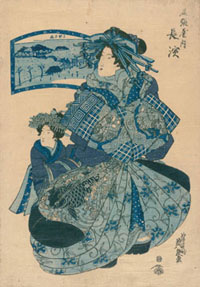History Special 4: About Zenjiro aka Keisai Eisen
I. THE IMPORTANCE OF BEING ZENJIRO Other than Hokusai and O-Ei, Miss Hokusai features another prominent artist, Keisai Eisen, called throughout the movie by his real name, Zenjiro. He is depicted as a young womanizer who is still striving with his immature artistic skills, and is often scolded by his master Hokusai, as well as object of O-Ei's contempt, as she quite brutally calls him "Brazen". Ikeda Zenjiro (1790-1848) was born to a samurai family, but started learning to draw at the age of 12 under Kano Hakkeisai of the Kano school. Then he shifted to comical playwriting under the name Chiyoda Saiichi, but went back to ukiyo-e becoming a pupil of Kikukawa Eizan (1787-1867), a highly respected portraitist of beauties. At the same time, Zenjiro was also fascinated by Hokusai's style, and was often to be seen at Hokusai's place, which was not far from Eizan's. He took the art name Keisai Eisen, and around the 1830s we find him as a manager of a brothel in Nezu (near Ueno), a business that ended abruptly when the building burned down.
II. SLANT EYES AND BERLIN BLUE In his late years, Eisen would describe himself as nothing more than a dissolute and decadent man. Indeed, he was to become famous for his portrays of voluptuous women, especially high-ranking courtesans (oiran) from Yoshiwara, all featuring his distinctive slant eyes, bizarre proportions and lavishly rendered kimonos. However, this apparently self-deprecating assessment should be taken as yet another example of Japanese understatement. Eisen proved to be greatly influential as an artist, and an intellectually acute man. He is considered one of the first artists to make an extensive use of Berlin blue (more commonly known as Prussian blue) a synthetic pigment that had to be imported through Dutch or Chinese merchants. Although Berlin blue had been used well before him, Eisen stood out because a number of his works, created exclusively using different shades of the same colour, obtained great commercial success. The Berlin blue fad that followed may have urged Hokusai's publisher Eijudo to make extensive use of Berlin blue in the Thirty-six Views of Mount Fuji series, including the famous Wave. Eisen is also said to have strongly influenced Utagawa Kunisada, the most commercially successful ukiyo-e artist of his age. Finally, Eisen was one of several writers and artists who edited and expanded upon the Ukiyo-e ruiko (History of Pictures of the Floating World), the most informative 18th-19th century source of facts on the lives of ukiyo-e artists. His version, published in 1833, contains the first ever dated written reference to O-Ei as a very talented artist.

III. MEETING VINCENT Eisen, or rather one of his prints, was to gain unexpected popularity in France and then in the rest of the world thanks to Vincent van Gogh, who was an avid collector of Japanese prints. Paris Illustré was a prestigious French illustrated magazine that started publication in 1883. The May 1886 issue was dedicated to Japan with a long article by Tadamasa Hayashi (1853-1903), a Japanese art dealer living in Paris, and the man who sold tens of thousands of prints to European collectors. Hayashi's article extensively described Japanese customs, history, climate and visual arts, and it is said to have greatly contributed to popularize Japonisme in France. The cover of the magazine featured a print of an oiran (high-ranking courtesan) by Eisen, but interestingly, it was reproduced on reverse. Eisen's gorgeously clad and subtly alluring courtesan must have had a deep impact into Van Gogh's imagination, because the Dutch painter, who had just moved to Paris, painstakingly traced and enlarged Eisen's original drawing, and in 1887 he completed his re-elaboration as an oil painting now known as The Courtesan (After Eisen). "Brazen" Zenjiro could not have possibly imagined so much international fame.
(fp)
(4 - to be continued)
© Production I.G

![WORK LIST[DETAILS]](/contents/works/design/images/left_title.gif)



 terms of use
terms of use